Clad in a thick black wetsuit, Shane Wilson emerges from the water like a slick, overgrown glossy black seal. Shaking off the sea, he boards the boat to show off his haul from the deep. I’m standing on the back deck of Cuttlefish, Tasmanian Wild Seafood Adventure’s 16.5-metre luxury catamaran and Shane has just caught my supper. It is the start of a food lover’s tour that delivers a deep to dish dining experience showcasing Tasmania’s best seafood. A gourmet seafood feast and coastal sailing adventure in one, where guests dine on fresh salmon, oysters, rock lobster, mussels and urchins while cruising through the waters where they are caught. You can also enjoy this as a shorter Tasmanian seafood sunset cruise.
Photo above: Shane Wilson shows off some fresh Tasmanian seafood which later became dinner! Photo: Kerry Heaney
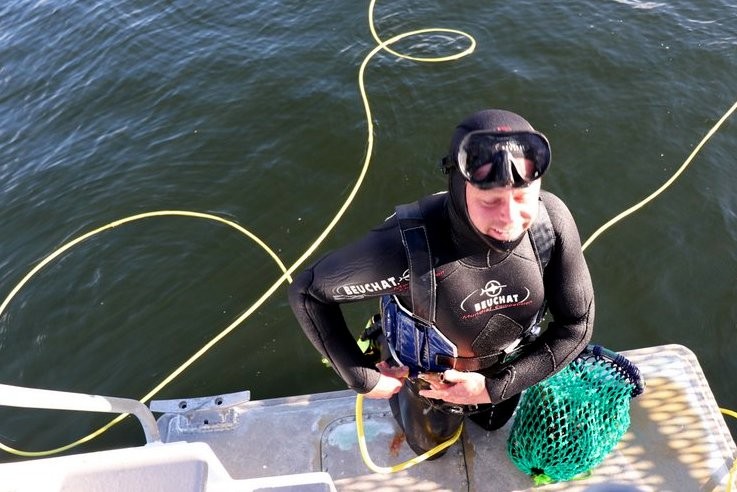
Tasmanian gourmet seafood
Moments earlier, Shane had been explaining Tasmania’s seafood wealth, and now he has the proof. Diving from the back deck into the depths of Bull Bay, he arose with a bag full of spiky sea urchins and hand-sized periwinkle shells, most destined for the dining table.
Shane is both skipper and diver on this cruise which offers true deep to dish dining delight. Leaving from Hobart’s easily accessible city Elizabeth Street Pier, the catamaran cruises swiftly down the Derwent River skipping around the towering cliffs of Taroona and Blackman’s Bay on morning and afternoon cruises.
Spiky sea urchins were in Shane’s deep ocean haul. Photo: Kerry Heaney


“I want to use these tours to show off the best fisheries on the Tasmanian coast,” he said.

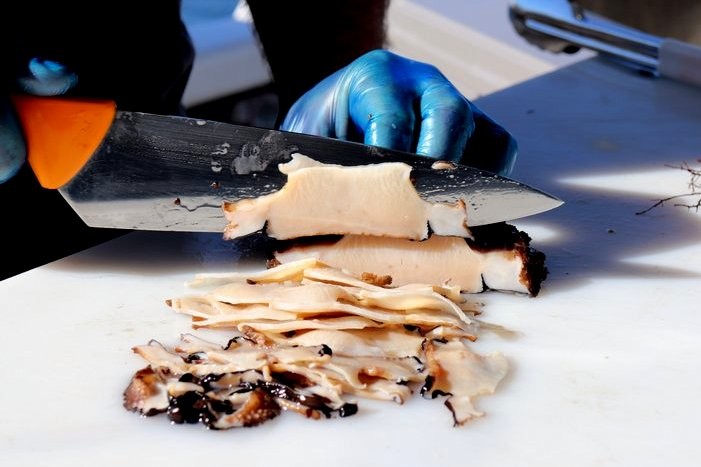
Slicing up abalone for the guests. Photo: Kerry Heaney
Tasmanian seafood fresh from the ocean
What better way to demonstrate the quality of these fisheries and Tasmanian gourmet seafood than by serving up just plucked from the ocean seafood?
Our seafood experience feast aboard Cuttlefish started with blacklip abalone and continued with crayfish, oysters, salmon, mussels and sea urchins.
Shane says 99 per cent of Tasmanian abalone is exported. With a retail price of $150 a kilo in China, it’s not hard to understand why.
“You can find abalone anywhere from half a metre to 30 metres deep. When you dive, the deeper you go, the less time you can spend there, so it’s a bit of a profit and loss that you have to run through in your head.”
Within a few minutes, the abalone is sliced and quickly fried with a little garlic and herb butter in a very hot wok over the burner. When it curls at the edges, it’s cooked, and then goes back into the shell for serving.

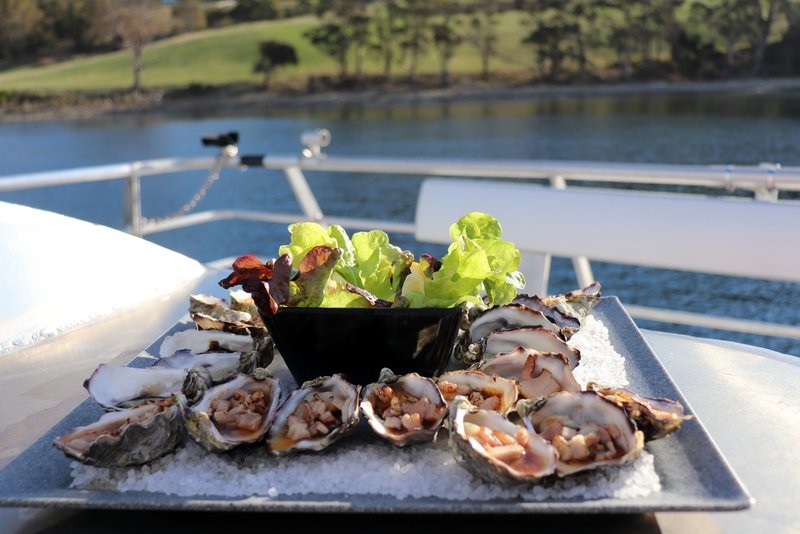
Oysters on the burner. Photo: Kerry Heaney
How do you like your oysters?
While Shane wanders around the ocean floor, fellow skipper Ben Dawe demonstrates oyster shucking with some of the three million dozen oysters harvested annually in Tasmania. Some are served natural, others broiled and topped with bacon fried with a blow torch.
Later, the boat pulls up outside a salmon farm, and Shane walks towards the filleting block with a large whole Atlantic salmon. It doesn’t stay unchanged for long. Small slices soon lie curing on a thick bed of pink rock salt, ready for the table.

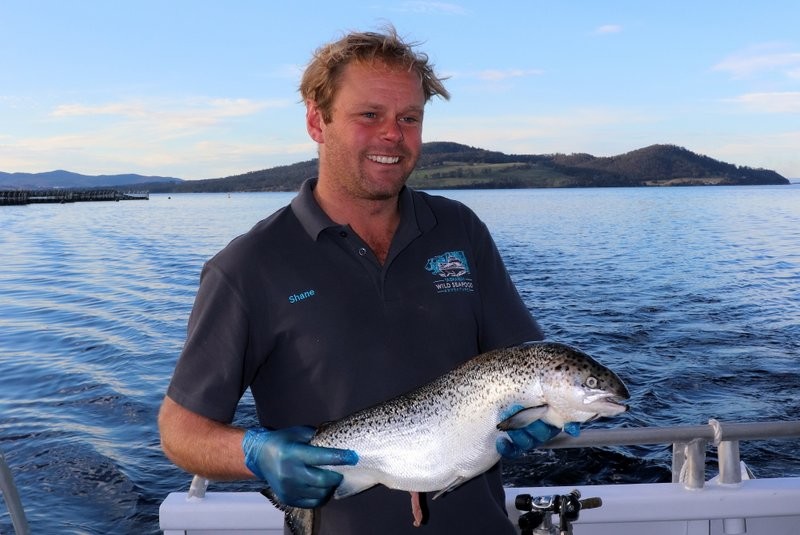
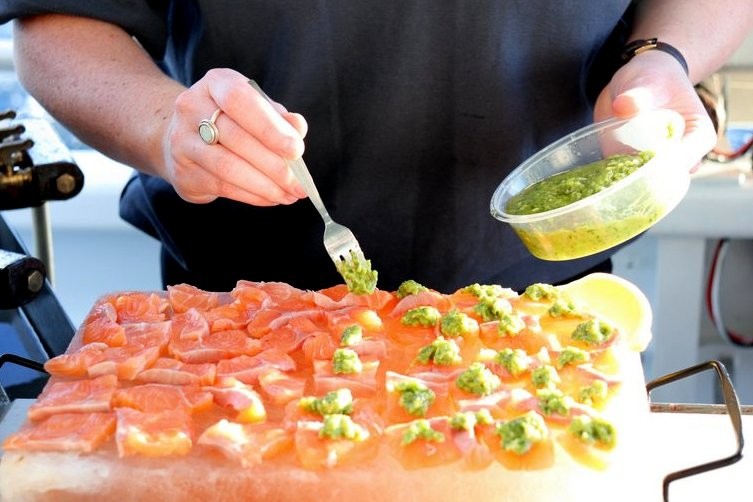
Freshly sliced salmon cures on a salt platter and is topped with pesto. Photo: Kerry Heaney
Tasmania’s whaling history
The sea has long been a resource for Hobart, starting with whaling in the early 1800s. Whales were so common that one imaginative local said you could ‘walk across the estuary on the backs of the whales without getting your feet wet’.
“The 1830s was the peak of whaling in Hobart, and it was the city’s biggest revenue earner,” says cruise guide Emma Ring. “It wasn’t uncommon to see up to 20 whales frolicking in the estuary. People were complaining about the disgusting smell the whales made when they blew out from their holes. Apparently, is it a bit like burping.”
There are no whales or even dolphins around today, but a hungry seal cases the salmon farm looking for his own Tasmanian seafood experience.
As the sun descends towards the water, Cuttlefish heads back to Hobart filled with contented guests confident that they have experienced Tasmanian seafood at its finest.
New Sunset Tasmanian Seafood Cruise
If you are looking for a shorter cruise,Tasmanian Wild Seafood Adventures has a new bespoke culinary offering, the Sunset River Cruise. This weekly two-hour cruise on a luxurious 55-foot catamaran along the River Derwent takes you to the towering Alum sea cliffs and offers uninterrupted views of Hobart from the water. It runs from 5 pm to 7 pm every Saturday and guests aboard the enjoy the finest Tasmanian seafood as well as a glass of Tasmanian sparkling or a mojito on arrival. The tour costs $150 per person.
The 10 am to 2.30 pm Deep to Dish tours costs $525 per person. You’ll enjoy a seafood feast including Tasmanian rock lobster, oysters, Blacklip abalone, mussels, urchin, Atlantic salmon, mussels and periwinkles, plus a Tasmanian seasonal cheese platter. There is also premium Tasmanian Beer, wine and sparkling including tea and coffee.
Explore Tasmania with these great ideas
- Craving a snowy adventure? Hobart has the easiest place to see snow in Australia.
- Discover the Harvest Launceston Farmers Market
- Explore Newdegate Cave and Hastings Cave
- Dine like a local at an RSL
Disclaimer: Ed+bK travelled on this Tasmanian Wild Seafood Cruise as a guest of Tourism Tasmania.



Sea urchins that fresh are definitely worth trying Linda. I really enjoyed the flavours of all the seafood, but the oysters and salmon were my favourites.
You could still enjoy a great day out on the water and they had some beautiful fruit platters too!
That’s an interesting question Alice! Commercial whaling ceased in Australia in 1978 with the closure of the last whaling station in Western Australia. I would guess that it ended long before that in Tasmania. There also is a sustainability plan in place for managing the blacklip abalone around Tasmania.
It absolutely a top day out and the seafood is amazing. You will love this Maggie.
Wow Wow wow!! It’s hard to get fresher seafood than that – what an incredible opportunity! It’s amazing that abalone costs that much in China – no wonder they export! Whenever I eventually get to Tasmania, I would love to do this.
I’ve always wanted to go to tasmania. Love that you included some of the history of whaling. When did that practice stop in tasmania, I would love to hear more about how they are keeping abalone sustainable as well.
Wow this looks like a seafood heaven for those that love it. I am vegetarian, and therefore do not eat meat or seafood. But it looks like quite the adventure for those that love it.
We were sorry we did not get back to Australia this year. And we definitely would have stopped in Tasmania. Since we are both seafood lovers, that would be enough of a reason even without the great spots to visit. Hubby might even try the sea urchins! Fresh from the ocean is definitely the best. And we would both try our hand at diving for our dinner!
This seafood cruise was absolute heaven for me, but my other outstanding Tasmanian seafood memory is eating oysters from a shack on Bruny Island. I was glad to try abalone, but after giving it the taste test, I do much prefer oysters and other shellfish. No accounting for tastes I suppose 🙂
Tasmania has such wonderful seafood. I remember eating the freshest oysters and mussels at a shack near Wineglass Bay, it was heaven. I would love to try and catch abalone, it looks delicious!